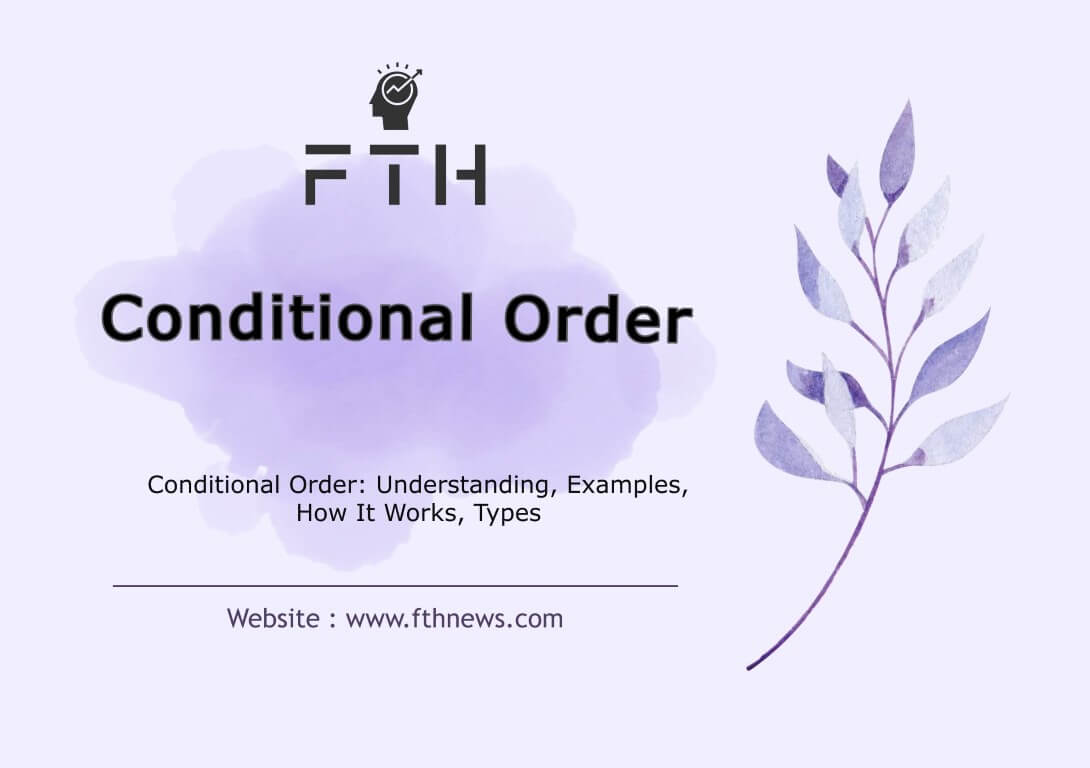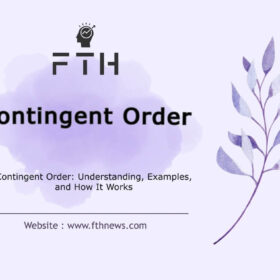
Conditional Order: Understanding, Examples, How It Works, Types
Conditional Order is the powerful tool In the dynamic world of trading, mastering the art of precision is key to success. . In this comprehensive guide, we’ll unravel the intricacies of Conditional Orders, focusing on their types, applications, and how they can be utilized in advanced trading strategies to gain a competitive edge.
Understanding Conditional Order
At its core, a Conditional Order is a trading order imbued with specific criteria. Typically associated with advanced trading strategies, these orders go beyond the simplicity of market orders.
The most familiar type is the Limit Order, which establishes a fixed price above or below which a transaction cannot occur. However, the complexity extends beyond price, incorporating factors like time-in-force and dependencies on other orders.
Types of Conditional Order:
Within the spectrum of Conditional Orders, a rich tapestry of order types emerges, each designed to cater to specific trading objectives. Let’s delve into these types, uncovering the intricacies that define and differentiate them:
1. Limit Orders: Precision in Execution
Limit Orders stand as the epitome of precision in trading. By establishing a predetermined price, traders ensure that a transaction is executed at the best possible price point. This not only maximizes potential gains but also shields traders from adverse market fluctuations.
2. Stop Orders: Safeguarding Against Volatility
Activated when the market hits a specified price point, Stop Orders act as vigilant safeguards against potential losses or as mechanisms to secure profits. These orders empower traders to automate responses to sudden market movements, providing a proactive approach to risk management.
3. Stop-Limit Orders: Merging Control and Flexibility
Combining the best of Limit and Stop Orders, the Stop-Limit Order adds a layer of control and flexibility. Initially functioning as a Stop Order, it transitions into a Limit Order only after a specific price is reached. This dual functionality allows traders to balance precision with adaptability in response to evolving market conditions.
4. Contingent Orders: A Nuanced Approach to Trading
Contingent Orders introduce a nuanced dimension to trading by making execution contingent upon the fulfillment of specific conditions. This type of order empowers traders to tailor their strategies to dynamic market scenarios. Whether it’s waiting for a related order to be completed or for a particular market condition to materialize, Contingent Orders provide a sophisticated level of control.
5. Trailing Stop Orders: Adapting to Market Trends
An additional type worth exploring is the Trailing Stop Order. This order type adjusts the stop price dynamically as the market moves in the trader’s favor. This allows traders to capitalize on favorable trends while protecting against sudden reversals. It’s a valuable tool for those looking to secure profits while letting winning positions continue to grow.
6. One-Cancels-the-Other (OCO) Orders: Managing Divergent Scenarios
For traders seeking to manage divergent scenarios, OCO Orders offer a solution. This order type allows the placement of two orders simultaneously, and the execution of one cancels the other. It’s particularly useful when traders anticipate two possible outcomes and want to be prepared for either scenario.
Incorporating these diverse Conditional Order types into your trading strategy provides a comprehensive toolkit for navigating the complexities of the financial markets. Whether it’s optimizing entry and exit points, managing risk, or adapting to evolving market conditions, the array of Conditional Orders empowers traders with the precision and flexibility needed for success.
Elevating Strategies with Conditional Order:
In the realm of advanced trading, Conditional Orders emerge as the linchpin, providing traders with a dynamic toolset to navigate the intricacies of financial markets. These orders empower traders to set precise conditions based on market movements, fostering a strategic approach where actions are only executed when specific criteria are met. This level of precision becomes particularly invaluable in volatile markets, where swift and calculated responses are paramount.
Strategic Precision in Action:
Conditional Orders serve as the bedrock of advanced trading strategies, allowing traders to articulate their tactics with a heightened level of strategic precision. By setting conditions tethered to market dynamics, traders gain the ability to automate responses, ensuring that every move aligns with their predefined strategies. This strategic alignment is crucial for maintaining discipline and consistency, essential elements in the pursuit of sustainable trading success.
Key Takeaways Reimagined:
Execution Refined by Criteria: Conditional Orders introduce a layer of control by only triggering when predefined criteria are met. This nuanced approach ensures that each trade is executed with precision, aligning with the trader’s strategic objectives. It transforms trading from a reactive process to a proactive one, enhancing the overall effectiveness of the strategy.
Versatility in Order Types: Explore a diverse array of Conditional Orders, each tailored to meet specific trading needs. From the precision of Limit Orders to the risk management capabilities of Stop and Stop-Limit Orders, and the nuanced strategies afforded by Contingent Orders, traders have a versatile toolkit at their disposal. This diversity enables a more adaptive and responsive trading approach.
Non-Guaranteed Execution Realities: It’s essential to acknowledge that Conditional Orders do not provide a guarantee of full or partial execution. The non-guaranteed nature arises from the inherent conditions set by the trader. While these conditions ensure strategic alignment, there is a trade-off in the form of uncertainty. Traders must navigate this aspect judiciously, factoring it into their risk management strategies.
How Conditional Order Work
Conditional orders are sophisticated tools in the realm of trading that allow investors to automate and customize their buy or sell transactions based on predefined conditions. These orders add a layer of complexity and strategy beyond simple market orders. Here’s a breakdown of how conditional orders work:
1. Defining Specific Criteria:
- Price Conditions: Traders can set specific price levels for buying or selling a security. For example, a trader may set a condition to buy a stock if its price drops to a certain level or sell it if the price rises to a particular threshold.
- Time Conditions: Traders can specify the duration for which the order remains active. This is known as the time-in-force parameter, determining how long the order will be in the market before it expires.
2. Types of Conditional Orders:
- Limit Orders: These orders specify the maximum price a buyer is willing to pay or the minimum price a seller is willing to accept. They only execute at the defined price or better.
- Stop Orders: Activated when the market reaches a specific price point, these orders help limit losses or secure profits by initiating a market order once the specified price is reached.
- Stop-Limit Orders: Combining features of both limit and stop orders, these convert to a limit order once a specified price is reached, providing a degree of control over the execution price.
- Contingent Orders: Execution depends on the fulfillment of specific conditions, offering a flexible and nuanced approach to trading.
3. Activation and Execution:
- Once the specified conditions are met, the conditional order is activated.
- The order is then sent to the market for execution.
- The execution can be in the form of a market order or a limit order, depending on the type of conditional order.
4. Examples of Conditional Orders in Action:
- Protective Stop-Loss: A trader holds a stock currently priced at $50 but sets a stop-loss order at $45. If the stock price falls to $45 or below, a market order is triggered to sell the stock, limiting potential losses.
- Profit-Taking Limit Order: A trader owns a stock priced at $60 and sets a limit sell order at $70. If the stock price reaches $70 or higher, a limit order is triggered to sell the stock, locking in profits.
5. Adaptability in Dynamic Markets:
- Conditional orders provide a way for traders to adapt to changing market conditions without constant monitoring.
- They help traders implement predefined strategies with discipline, reducing the emotional component of trading.
6. Non-Guaranteed Execution:
- It’s important to note that conditional orders do not guarantee execution. If the market does not meet the specified conditions, the order may not be executed fully or at all.
7. Risk Management:
- Traders often use conditional orders as part of their risk management strategy to automate responses to market movements and protect their investments.
Understanding how conditional orders work allows traders to harness these tools effectively, adding precision and automation to their trading strategies in various market scenarios.
Examples of Conditional Orders
Let’s walk through a couple of examples to illustrate how different types of conditional orders work in real-world trading scenarios:
Example 1: Protective Stop-Loss Order
Imagine you own 100 shares of XYZ Company, currently trading at $50 per share. Worried about potential losses if the stock price drops, you decide to set up a protective stop-loss order.
Conditional Order: Stop-Loss
- Current Stock Price: $50
- Stop-Loss Price: $45
Scenario:
- If the stock price falls to $45 or below, the stop-loss order is triggered.
- A market order is then placed to sell your 100 shares.
Outcome:
- This helps limit potential losses by automatically selling the stock if it experiences a significant decline.
Example 2: Profit-Taking Limit Order
Now, let’s assume the same scenario with XYZ Company, but this time you want to secure profits if the stock reaches a certain price.
Conditional Order: Limit Sell Order
- Current Stock Price: $60
- Target Price: $70
Scenario:
- If the stock price reaches $70 or higher, the limit sell order is triggered.
- A limit order is placed to sell your 100 shares at $70 or better.
Outcome:
- This allows you to automatically sell your shares at a predetermined profit level, taking advantage of upward price movements.
Example 3: Contingent Order Based on Market Conditions
Suppose you are monitoring two correlated stocks, A and B, and you want to buy stock A only if stock B reaches a certain price level.
Conditional Order: Contingent Order
- Condition: Buy 100 shares of stock A if stock B reaches $100.
Scenario:
- Stock B’s price reaches $100, triggering the contingent order.
- market order is placed to buy 100 shares of stock A.
Outcome:
- This strategy allows you to synchronize your trades based on specific market conditions or relationships between different assets.
These examples showcase the versatility of conditional orders in executing specific trading strategies. Traders use these tools to manage risk, secure profits, and implement intricate trading plans with a level of automation that responds to the dynamic nature of financial markets.
Advantages of Conditional Orders:
- Precision and Automation:
- Advantage: Conditional orders allow for precise and automated execution of trades based on predetermined criteria. This reduces the need for constant monitoring and manual intervention.
- Risk Management:
- Advantage: Traders can use conditional orders to implement risk management strategies. Stop-loss orders, for example, help limit potential losses by automatically selling an asset if it reaches a specified price.
- Strategic Planning:
- Advantage: Conditional orders enable traders to plan and execute strategies with discipline. Whether it’s entering or exiting positions, these orders help traders stick to predefined plans.
- Adaptability to Market Conditions:
- Advantage: In dynamic markets, conditional orders provide adaptability. Traders can respond to changing market conditions without being actively present, ensuring they don’t miss opportunities or incur unnecessary risks.
Disadvantages of Conditional Orders:
- No Guarantee of Execution:
- Disadvantage: Conditional orders do not guarantee execution. If market conditions don’t meet the specified criteria, the order may not be executed fully or at all.
- Complexity and Risk of Error:
- Disadvantage: Implementing complex conditional orders requires a good understanding of trading platforms. There’s a risk of human error in setting up these orders, potentially leading to unintended consequences.
- Market Volatility Challenges:
- Disadvantage: In highly volatile markets, rapid price movements can trigger conditional orders quickly. This may result in executions at less favorable prices than anticipated.
- Dependency on Technology:
- Disadvantage: Conditional orders rely on the functionality of trading platforms and internet connectivity. Technical glitches or platform downtime could impact the execution of these orders.
In summary, while conditional orders offer valuable tools for strategic and automated trading, traders should be aware of their limitations and potential risks. It’s crucial to use these orders judiciously, considering market conditions and one’s risk tolerance.
Conclusion:
In the world of trading, where split-second decisions can make or break fortunes, mastering Conditional Orders is a game-changer. This guide has provided insights into the intricacies of these orders, from their basic definition to advanced strategies. By incorporating Conditional Orders into your trading toolkit, you’re not just navigating the market; you’re doing so with precision and strategy, paving the way for success.
Remember, in the ever-evolving landscape of trading, staying informed and adapting to new strategies is key. Use this guide as a stepping stone to explore and master the world of Conditional Orders, and propel your trading journey to new heights.
FAQ
To set a conditional order, access your trading platform, choose the stock, and select “Conditional Order” or a similar option. Specify conditions like price levels or time triggers for automatic execution.
A conditional purchase order is a trading directive that executes a buy transaction based on predetermined conditions. It ensures the purchase occurs only when specific criteria, such as a set price, are met.
A conditional trade is a transaction executed based on predefined conditions. These conditions can include specific prices, time frames, or other criteria, allowing for automated and strategic trading.














